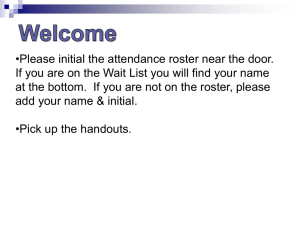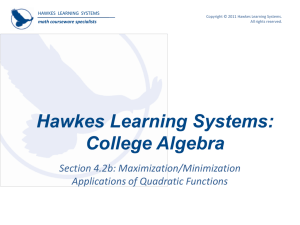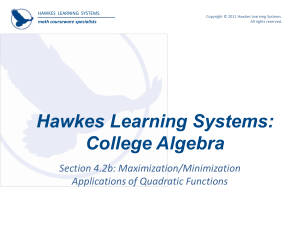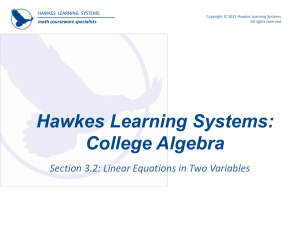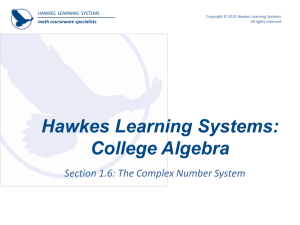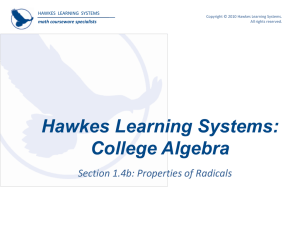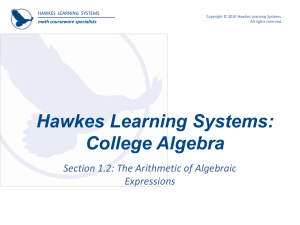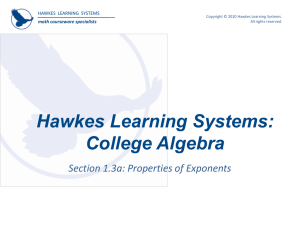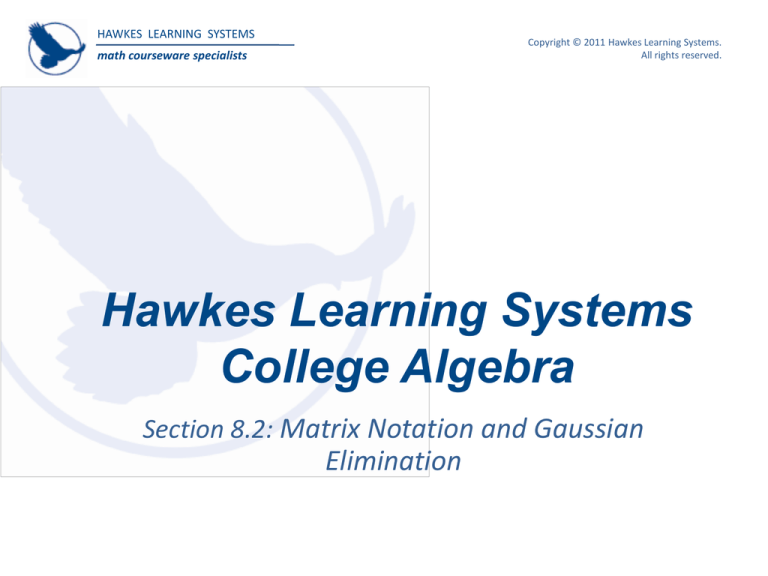
HAWKES LEARNING SYSTEMS
Copyright © 2011 Hawkes Learning Systems.
All rights reserved.
math courseware specialists
Hawkes Learning Systems
College Algebra
Section 8.2: Matrix Notation and Gaussian
Elimination
HAWKES LEARNING SYSTEMS
Copyright © 2011 Hawkes Learning Systems.
All rights reserved.
math courseware specialists
Objectives
o Linear systems, matrices, and augmented matrices.
o Gaussian elimination and row echelon form.
o Gauss-Jordan elimination and reduced row echelon
form.
HAWKES LEARNING SYSTEMS
Copyright © 2011 Hawkes Learning Systems.
All rights reserved.
math courseware specialists
Linear Systems and Matrices
Matrices and Matrix Notation
A matrix is a rectangular array of numbers, called elements
or entries of the matrix. They naturally form rows and
columns. We say that a matrix with m rows and n columns
is an m n matrix (read “m by n”), or of order m n . By
convention, the number of rows is always stated first.
5 9 7
A
2
6
0
A is a 2x3 matrix.
HAWKES LEARNING SYSTEMS
Copyright © 2011 Hawkes Learning Systems.
All rights reserved.
math courseware specialists
Linear Systems and Matrices
Matrices are often labeled with capital letters. The same
letter in lower case, with a pair of subscripts attached, is
usually used to refer to its individual elements. For instance,
if A is a matrix, aij refers to the element in the i th row and
the j th column of A.
5 9 7
A
2
6
0
a12 9
HAWKES LEARNING SYSTEMS
math courseware specialists
Copyright © 2011 Hawkes Learning Systems.
All rights reserved.
Example 1: Linear Systems and Matrices
Given the matrix below, determine the following:
5 9
2 6
A
7 0
5 3
a. The order of A . A has 4 rows and 2 columns, so A is a 4x2 matrix.
4 2
b. The value of a32. The first subscript refers to the row and the
second subscript refers to the column, so find the
0
entry in the 3rd row and 2nd column.
c. The value of a11 . Similarly, find the entry in the 1st row, 1st column.
5
HAWKES LEARNING SYSTEMS
math courseware specialists
Copyright © 2011 Hawkes Learning Systems.
All rights reserved.
Linear Systems and Augmented Matrices
Augmented Matrices
The augmented matrix of a linear system of equations is a
matrix consisting of the coefficients of the variables, with
an adjoined column consisting of the constants from the
right-hand side of the system. The matrix of coefficients and
the column of constants are customarily separated by a
vertical bar.
For example, the augmented matrix for the system
3 x 7 y 4
3 7 4
is
.
9
x 4 y 9
1 4
HAWKES LEARNING SYSTEMS
Copyright © 2011 Hawkes Learning Systems.
All rights reserved.
math courseware specialists
Example 2: Linear Systems and Augmented Matrices
Construct the augmented matrix for the linear system.
2 x 5 y 1 6 z
6 x 12 z
2 y
3
z 3 x 7 y 9
2x 5 y 6z 1
2x y 4z 2
3x 7 y z 9
2 5 6 1
2 1 4 2
3 7 1 9
Our first step is to
write each
equation in
standard form.
Now we can
convert the
coefficients and
constants into an
augmented matrix.
HAWKES LEARNING SYSTEMS
math courseware specialists
Copyright © 2011 Hawkes Learning Systems.
All rights reserved.
Example 3: Linear Systems and Augmented Matrices
Construct the linear system for the augmented matrix.
0 8 3 5 12 First, we need to assign each of the
9 1 0 0 7 coefficient columns to a variable.
5 Now we can create the system of equations.
2 0 0 2
a b c d
0a 8b 3c 5d 12
9a b 0c 0d 7
2a 0b 0c 2d 5
8b 3c 5d 12
9a b 7
2a 2d 5
HAWKES LEARNING SYSTEMS
math courseware specialists
Copyright © 2011 Hawkes Learning Systems.
All rights reserved.
Gaussian Elimination and Row Echelon Form
Consider the following augmented matrix.
1 2 3 10
0 1 4 7
0 0 1 1
If we translate this back into system form we obtain
x 2 y 3z 10
y 4 z 7
z 1
and can easily solve for the variables by back substitution.
z 1
y 4 1 7
x 2 3 3 1 10
x7
y 3
HAWKES LEARNING SYSTEMS
math courseware specialists
Copyright © 2011 Hawkes Learning Systems.
All rights reserved.
Gaussian Elimination and Row Echelon Form
The point of Gaussian elimination is that it transforms an
arbitrary augmented matrix into a form (called row echelon
form) like the one on the previous slide.
Row Echelon Form
A matrix is in row echelon form if:
1. The first non-zero entry in each row is 1.
2. Every entry below each 1 (called a leading 1) is 0, and
each leading 1 appears one digit farther to the right
than the leading 1 in the previous row.
3. All rows consisting entirely of 0’s appear at the bottom.
HAWKES LEARNING SYSTEMS
math courseware specialists
Copyright © 2011 Hawkes Learning Systems.
All rights reserved.
Row Echelon Form
The matrix below is in row echelon form.
1 9 1 1
A 0 1 0 2
0 0 1 3
However, the matrix below is not in row echelon form
1 2 3 4
B 0 4 7 2
0 6 0 0
because the first non-zero entries in the second and
third rows are not 1.
HAWKES LEARNING SYSTEMS
math courseware specialists
Copyright © 2011 Hawkes Learning Systems.
All rights reserved.
Gaussian Elimination and Row Echelon Form
Elementary Row Operations
Assume A is an augmented matrix corresponding to a given
system of equations. Each of the following operations on A
results in the augmented matrix of an equivalent system. In
the notation, Ri refers to row i of the matrix A.
1. Rows i and j can be interchanged. (Denoted Ri R j )
2. Each entry in row i can be multiplied by a non-zero
constant c . (Denoted cRi )
3. Row j can be replaced with the sum of itself and a
constant multiple of row i . (Denoted cRi R j )
HAWKES LEARNING SYSTEMS
Copyright © 2011 Hawkes Learning Systems.
All rights reserved.
math courseware specialists
Example 4: Gaussian Elimination and Row
Echelon Form
Use Gaussian Elimination to solve the system.
7 x y 4 z 11
x 3y 2 z 13
6 x 2 y 3z 22
R1 R2
Augmented
matrix form
7 1 4 11
1 3 2 13
6 2 3 22
1 3 2 13 7R R
7 1 4 11 1 2
6R1 R3
6 2 3 22
3 2 13
1
0 20 10 80
0 20 15 100
Continued on the next slide…
HAWKES LEARNING SYSTEMS
Copyright © 2011 Hawkes Learning Systems.
All rights reserved.
math courseware specialists
Example 4: Gaussian Elimination and Row
Echelon Form (Cont.)
3 2 13
1
0 20 10 80
0 20 15 100
20R2 R3
1 3 2 13
1
0 1
4
2
0 0 5 20
1
R2
20
1
R3
5
1
0
0
1
0
0
3 2 13
1
1
4
2
20 15 100
3 2 13
1
1
4
2
0
1 4
The final matrix is in row echelon form.
Continued on the next slide…
HAWKES LEARNING SYSTEMS
Copyright © 2011 Hawkes Learning Systems.
All rights reserved.
math courseware specialists
Example 4: Gaussian Elimination and Row
Echelon Form (Cont.)
1 3 2 13
1
0 1
4
2
0 0
1
4
Now we can solve for x, y and z.
z 4 Given by the last row of the matrix.
Plug the value found for z into the equation
1
y
4 4 given by the 2nd row of the matrix.
2
y2
x 3 2 2 4 13
x 1
1,2, 4
Plug the values found for y and z into the 1st row
of the matrix.
The solution set to this system.
HAWKES LEARNING SYSTEMS
Copyright © 2011 Hawkes Learning Systems.
All rights reserved.
math courseware specialists
Example 5: Gaussian Elimination and Row
Echelon Form
Use Gaussian Elimination to solve the system.
x y 9 z 16
x 3y 4 z 6
2 x 6 y 38z 10
R1 R2
2R1 R3
1 1 9 16
0 2 5 10
0 8 20 22
1 1 9 16
Augmented
1 3 4
6 matrix form
2 6 38 10
4R2 R3
1 1 9 16
0 2 5 10
0 0 0 62
We can stop here because 0 62 is a false statement. Therefore,
the solution set
HAWKES LEARNING SYSTEMS
math courseware specialists
Copyright © 2011 Hawkes Learning Systems.
All rights reserved.
Gauss-Jordan Elimination and Reduced Row
Echelon Form
The goal of Gauss-Jordan elimination is to put a given
matrix into reduced row echelon form.
Reduced Row Echelon Form
A matrix is said to be in reduced row echelon form if:
1. It is in row echelon form.
2. Each entry above a leading 1 is also 0.
For example, the following matrix is in reduced row
echelon form. 1 0 0 2
0 1 0 17
0 0 1 3
HAWKES LEARNING SYSTEMS
Copyright © 2011 Hawkes Learning Systems.
All rights reserved.
math courseware specialists
Gauss-Jordan Elimination and Reduced Row
Echelon Form
Consider the last matrix obtained in Example 4.
1 3 2 13 1
5
R3 R2 1 3 0
2
1
0 1 0 2
0 1
4
2
2R3 R1
0 0 1 4
0 0 1 4
3R2 R1
1 0 0 1
0 1 0 2
0 0 1 4
Reduced row echelon
form.
Now we can write
the system as
x 1
y 2
z 4
which is equivalent to the original system, but in a form that tells us the
solution to the system.
HAWKES LEARNING SYSTEMS
Copyright © 2011 Hawkes Learning Systems.
All rights reserved.
math courseware specialists
Example 6: Gauss-Jordan Elimination and
Reduced Row Echelon Form
Use Gauss-Jordan elimination to solve the system.
x 2 y 3 z 7
3x y 5 z 7
8 x 10 y 19 z 1
3R1 R2
8R1 R3
2R2 R1
6R2 R3
1 2 3 7
3
1
5
7
8 10 19 1
1 2 3 7
0
7
14
28
0 6 43 55
1
R2
7
1 2 3 7
0
1
2
4
0 6 43 55
1 0 1 1
0
1
2
4
0 0 31 31
1
R3
31
1 0 1 1
0 1 2 4
0 0 1 1
HAWKES LEARNING SYSTEMS
Copyright © 2011 Hawkes Learning Systems.
All rights reserved.
math courseware specialists
Example 6: Gauss-Jordan Elimination and
Reduced Row Echelon Form (Cont.)
1 0 1 1
0 1 2 4
0 0 1 1
2R3 R2
1R3 R1
1 0 0 0
0 1 0 2
0 0 1 1
Thus, we can write this in system form
x 0
y 2
z 1
and the solution set for this system is the ordered triple
0, 2,1 .

